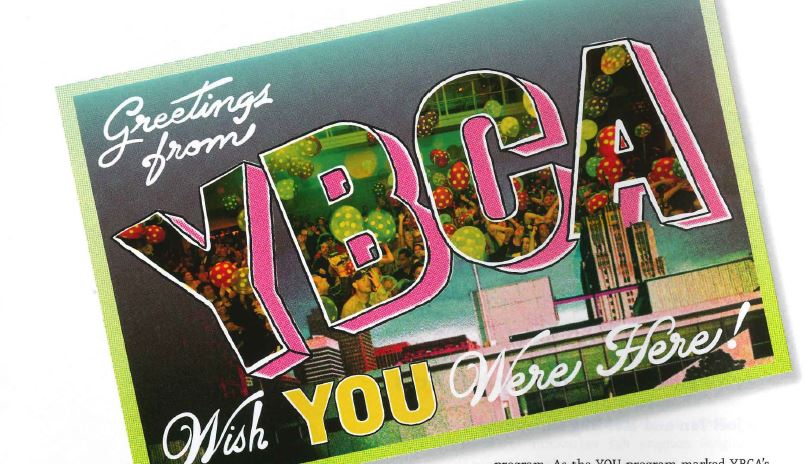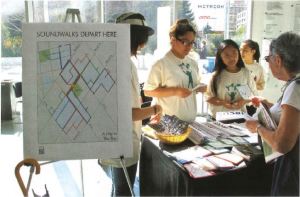
This article originally appeared in the January/February 2013 edition of the Museum magazine.
Museum has been chronicling the progress of the Alliance’s Innovation Lab for Museums, a grant-funded program that enables participants to incubate organizational innovation in a lab-like setting over 18 to 24 months. With funding from the MetLife Foundation, Innovation Lab for Museums is a partnership with EmcArts to adapt their successful Innovation Lab program (originally designed for the performing arts) to serve the museum field.
In the July/August 2012 issue, we introduced the program. This past fall, Priscilla Hancock Cooper of the Levine Museum of the New South described her institution’s relationship with the Atlanta History Center and the Birmingham Civil Rights Institute in the Latino New South Project- breaking ground in how museums collaborate as they address Latino immigration in their region.
Now we hear from San Francisco’s Yerba Buena Center for the Arts (YBCA), which is reshaping its youth arts program to encourage participants to become creative thinkers and agents of social change. The result could be a model for other museums and even for youth arts education generally. The YBCA’s Joel Tan and Mei-ling Humphrey describe in the following pages what it’s like to go through the innovation process.
Next up: A report from the Nelson-Atkins Museum of Art, which is working to transform its relationship with its visitors. Stay tuned.
“Stillness. I wonder what it would be like to introduce the practice of stillness, focus and presence in youth arts education. Instead of adding to their already-full plates with more extracurricular experiences, what if we balanced “busy” with decompression practices like meditation or Qi Gong-a practice aligning breath, movement and physical movement to help young artists improve their focus and concentration? The practice of stillness and the habitual quieting of one’s self allows young artists to be more present in their creative endeavors. Now if only we could get them to look up from their cell phones and other hand-held devices …. ” -JOEL TAN. DIRECTOR OF COMMUNITY ENGAGEMENT
Verba Buena Center for the Arts
If there were one thing we could say about the process of innovation, it would be this: Get ready for things to get messy.
When the Yerba Buena Center for the Arts (YBCA) was awarded the Innovation Lab grant in early 2012, the museum was already in the process of implementing several innovative reforms to our focus and programming, resulting from an Innovation grant awarded in 2008. It was through that grant that YBCA created its cornerstone membership program YBCA: YOU, based on the premise that the engagement between the audience and art is the center of the museum experience, as opposed to the relationship between art and artist. This was a fundamental turning point for us, signaling a deep organizational change and a shift towards future programming built on fostering connections and creating customizable, personalized experiences for members based on their interests.
Not surprisingly, the innovation that evolved from the previous grant became the basis for the second-taking the newly defined principles of the YOU program and applying them to the youth arts program-not just through the development of new program initiatives, but through an extended period of discovering, testing and finally manifesting what our values truly are.
This past November, we gathered in the conference room: 15 staff members plus one EmcArts representative, Melissa Dibble. The agenda for our meeting was to evaluate our prototyping process thus far. Evaluations are not glamourous-they are searching, repetitive and sometimes dull-unless of course there is real passion behind the work, something that comes most naturally when working with youth (a recurring theme of the meeting). After the round of introductions, Dibble got down to business, Beginning with: “What were some things that surprised you about this process?”
“I was surprised,” responded Roko Kawai, our performing arts coordinator, and volunteer mentor, “at not just how time commitment could be an issue with staff, but with the youth themselves! Their time is utterly overtaxed by everything they have with school, college prep, home life-and that’s before their commitment to the Young Artists at Work (YAAW) program.”
All around were murmurs of agreement. This was a profound learning moment for us. The cogs began turning for me. I recalled an article that Executive Director Ken Foster sent to me on Generation Flux, the current hip theory that purports successful professionals today are those who embrace instability, accept that culture never stops and are therefore prepared to roll with the (ever-constant) punches. But how does one reconcile Generation Flux theory with Kawai’s surprise? Are we, I thought, only intensifying the already-problematic “culture of busy”?
Laurel Butler, YBCA’s youth arts program manager, was already in the process of changing the structure of the YAAW program from a more typical afterschool arts education program into a highly customized young artist residency when we received our second Lab grant. As the person previously in charge of prototyping and ultimately launching YBCA: YOU, Butler was in a unique position to expand the innovative process started a year ago into the youth arts program. As the YOU program marked YBCA’s movement towards centering the audience as the institutional driver, so is Youth Arts: Present/Future reacting against the assumption that arts programs create artists. As the YBCA Youth Arts Manifesto explains, we are aiming to build a program that “[commits] our whole institution to the idea of being a place in which both artists and YBCA staff listen to, engage with, instruct, mentor and learn from young people… [making] YBCA a vital, transformative place for all people, regardless of their age.”
This is not school.
Confession: We don’t really know what that means. We do know it resonates deeply with what we’re trying to achieve with our youth arts education. We know it speaks to a critique of the No Child Left Behind education paradigm, pushing us to embrace high-imagination pedagogy, project-based learning methods and flexible courses that evolve as ideas evolve. Again, it’s about fostering connections, and quality ones at that.
Mess-real mess-is a dynamic, beautiful thing. Even with an entire team of enthusiastic people all working with the best intentions, striving to create ideal conditions, things can and will fail. Months of planning went into our first remote exchange with an overseas artist as part of our prototype, Go Deep with Global Artists, seeking to test our ability to leverage technology to create and maintain long-term, deeper relationships with artists who may not be on-site at YBCA. To be perfectly clear, months means months, and strive means strive. In the end, all we had to show for it were three bored-stiff youth sitting in front of a Skype window with erratic connection at best, trying to engage

with a performance artist who refused to lesson-plan or even emerge from the shadows, an hour late on a Saturday morning because apparently Europe starts daylight savings a week before the U.S. (We won’t even mention the fact that we had to provide incentives to just get youth to participate. See above, re: culture of busy.)
But contrast that mess with our typical Tuesdays when 30-odd youth permeate YBCA, working on individual projects with their staff advisors or meeting with mentors over tea; when small groups of youth gather and devise marketing strategies for dance workshops they curated and organized themselves. Or, when after several weeks of banging our heads against· the wall trying to set realistic expectations for a staff-run blogging course, two youths were given iPads and live-blogged YBCA’s election night party, which engaged them and turned out fabulously.
“The opportunity tore-frame our expectations of ourselves was clear: When working with youth.
just bring your authentic presence. In the world of hyper-busy, the greatest service we adults can
provide our youth is not more assignments or more advice but a safe space and a sounding board
for them to explore their own creativity (and, likely, to teach us a few things in the meantime).”
-LAUREL BUTLER. YOUTH ARTS PROGRAM MANAGER
It’s when things get really, really messy that truly enlightened solutions surface. What we continue to learn through our second Innovation Lab grant is that the real value of the awards is in giving organizations the time, resources and permission to shift culture, which as we know takes time, inspiration, chaos, blood, sweat, tears and more time. By agreeing to test assumptions as a group, we leave ourselves exposed and vulnerable. On an individual level, it makes one confront one’s own experiences with failure. This is absolutely not for the faint-hearted, and it helps when you’ve had practice not trying to look good. Which we don’t, and that’s OK.
Joel Tan is director of community engagement and Mei-ling Humphrey is Youth Arts Innovation Lab prototype coordinator, Yerba Buena Center for the Arts, San Francisco.







